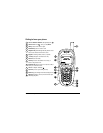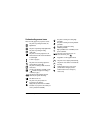
User Guide for Kyocera Phantom Phones iii
FCC/IC Notice
This device complies with part 15 of the FCC rules.
Operation is subject to the following two conditions:
(1) This device may not cause harmful interference,
and (2) this device must accept any interference
received, including interference that may cause
undesired operation.
To maintain compliance with FCC RF exposure
guidelines, if you wear a handset on your body,
use the Kyocera Wireless Corp. (KWC) supplied
and approved:
Phone Case Model: TXLCC10042B
Belt Clip Model: TXLCC10047B
Sport Clip Model: TXLCC10045B
Other accessories used with this device for body-worn
operations must not contain any metallic components
and must provide at least 22.5 mm separation distance
including the antenna and the user’s body.
THIS MODEL PHONE MEETS THE GOVERNMENT’S
REQUIREMENTS FOR EXPOSURE TO RADIO WAVES.
Your wireless phone is a radio transmitter and receiver.
It is designed and manufactured not to exceed the
emission limits for exposure to radio frequency (RF)
energy set by the Federal Communications
Commission of the U.S. Government. These limits are
part of comprehensive guidelines and establish
permitted levels of RF energy for the general
population. The guidelines are based on standards that
were developed by independent scientific
organizations through periodic and thorough
evaluation of scientific studies. The standards include a
substantial safety margin designed to assure the safety
of all persons, regardless of age and health. The
exposure standard for wireless mobile phones
employs a unit of measurement known as the Specific
Absorption Rate, or SAR. The SAR limit set by the
FCC is 1.6 W/kg.* Tests for SAR are conducted using
standard operating positions specified by the FCC with
the phone transmitting at its highest certified power
level in all tested frequency bands. Although the SAR
is determined at the highest certified power level, the
actual SAR level of the phone while operating can be
well below the maximum value.
This is because the phone is designed to operate at
multiple power levels so as to use only the power
required to reach the network. In general, the closer
you are to a wireless base station antenna, the lower
the power output.
Before a phone model is available for sale to the
public, it must be tested and certified to the FCC that
it does not exceed the limit established by the
government-adopted requirement for safe exposure.
The tests are performed in positions and locations
(e.g., at the ear and worn on the body) as required
by the FCC for each model. The highest SAR values
for these model phones are:
AMPS/CDMA modes (Part 22) - Head: 1.37 W/kg;
Body-worn: 0.66 W/kg
PCS/CDMA mode (Part 24) - Head: 1.36 W/kg;
Body-worn: 0.47 W/kg
Body-worn measurements differ among phone
models, depending upon availability of accessories
and FCC requirements. The body-worn SAR values
provided above were obtained by using Kyocera
Wireless Corp. [KWC] supplied and approved:
Phone Case Model: TXLCC10042B
Belt Clip Model: TXLCC10047B
Sport Clip Model: TXLCC10045B
While there may be differences between
the SAR levels of various phones and at various
positions, they all meet the government requirement
for safe exposure.
The FCC has granted an Equipment Authorization for
this model phone with all reported SAR levels
evaluated as in compliance with the FCC RF emission
guidelines. SAR information on this model phone is
on file with the FCC and can be found under the
Display Grant section
http://www.fcc.gov/oet/fccid
after searching on the FCC ID: OVFKWC-K4X4
Additional information on SAR can be found on the
Cellular Telecommunications and Internet Association
(CTIA) web-site at
http://www.wow-com.com.
* In the United States and Canada, the SAR limit for
mobile phones used by the public is 1.6 watts/kg (W/
kg) averaged over one gram of tissue. The standard
incorporates a substantial margin of safety to give
additional protection for the public and to account for
any variations in measurements.


















